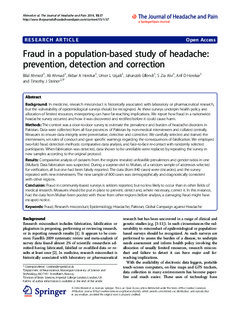| dc.contributor.author | Ahmed, B | |
| dc.contributor.author | Ahmad, A | |
| dc.contributor.author | Herekar, AA | |
| dc.contributor.author | Uquaili, UL | |
| dc.contributor.author | Effendi, J | |
| dc.contributor.author | Alvi, SZ | |
| dc.contributor.author | Herekar, AD | |
| dc.contributor.author | Steiner, Timothy J. | |
| dc.date.accessioned | 2015-01-06T09:22:08Z | |
| dc.date.accessioned | 2016-04-20T13:53:07Z | |
| dc.date.available | 2015-01-06T09:22:08Z | |
| dc.date.available | 2016-04-20T13:53:07Z | |
| dc.date.issued | 2014 | |
| dc.identifier.citation | Journal of Headache and Pain 2014, 15 | nb_NO |
| dc.identifier.issn | 1129-2369 | |
| dc.identifier.uri | http://hdl.handle.net/11250/2386559 | |
| dc.description.abstract | Background: In medicine, research misconduct is historically associated with laboratory or pharmaceutical research,
but the vulnerability of epidemiological surveys should be recognized. As these surveys underpin health policy and
allocation of limited resources, misreporting can have far-reaching implications. We report how fraud in a nationwide
headache survey occurred and how it was discovered and rectified before it could cause harm.
Methods: The context was a door-to-door survey to estimate the prevalence and burden of headache disorders in
Pakistan. Data were collected from all four provinces of Pakistan by non-medical interviewers and collated centrally.
Measures to ensure data integrity were preventative, detective and corrective. We carefully selected and trained the
interviewers, set rules of conduct and gave specific warnings regarding the consequences of falsification. We employed
two-fold fraud detection methods: comparative data analysis, and face-to-face re-contact with randomly selected
participants. When fabrication was detected, data shown to be unreliable were replaced by repeating the survey in
new samples according to the original protocol.
Results: Comparative analysis of datasets from the regions revealed unfeasible prevalences and gender ratios in one
(Multan). Data fabrication was suspected. During a surprise-visit to Multan, of a random sample of addresses selected
for verification, all but one had been falsely reported. The data (from 840 cases) were discarded, and the survey
repeated with new interviewers. The new sample of 800 cases was demographically and diagnostically consistent
with other regions.
Conclusion: Fraud in community-based surveys is seldom reported, but no less likely to occur than in other fields of
medical research. Measures should be put in place to prevent, detect and, where necessary, correct it. In this instance,
had the data from Multan been pooled with those from other regions before analysis, a damaging fraud might have
escaped notice. | nb_NO |
| dc.language.iso | eng | nb_NO |
| dc.publisher | SpringerOpen | nb_NO |
| dc.rights | Navngivelse 3.0 Norge | * |
| dc.rights.uri | http://creativecommons.org/licenses/by/3.0/no/ | * |
| dc.title | Fraud in a population-based study of headache: prevention, detection and correction | nb_NO |
| dc.type | Journal article | nb_NO |
| dc.type | Peer reviewed | nb_NO |
| dc.date.updated | 2015-01-06T09:22:08Z | |
| dc.source.volume | 15 | nb_NO |
| dc.source.journal | Journal of Headache and Pain | nb_NO |
| dc.identifier.doi | 10.1186/1129-2377-15-37 | |
| dc.identifier.cristin | 1188708 | |
| dc.description.localcode | © Ahmed et al.; licensee Springer. 2014. This article is published under license to BioMed Central Ltd. This is an Open Access article distributed under the terms of the Creative Commons Attribution License (http://creativecommons.org/licenses/by/4.0), which permits unrestricted use, distribution, and reproduction in any medium, provided the original work is properly credited. | nb_NO |

